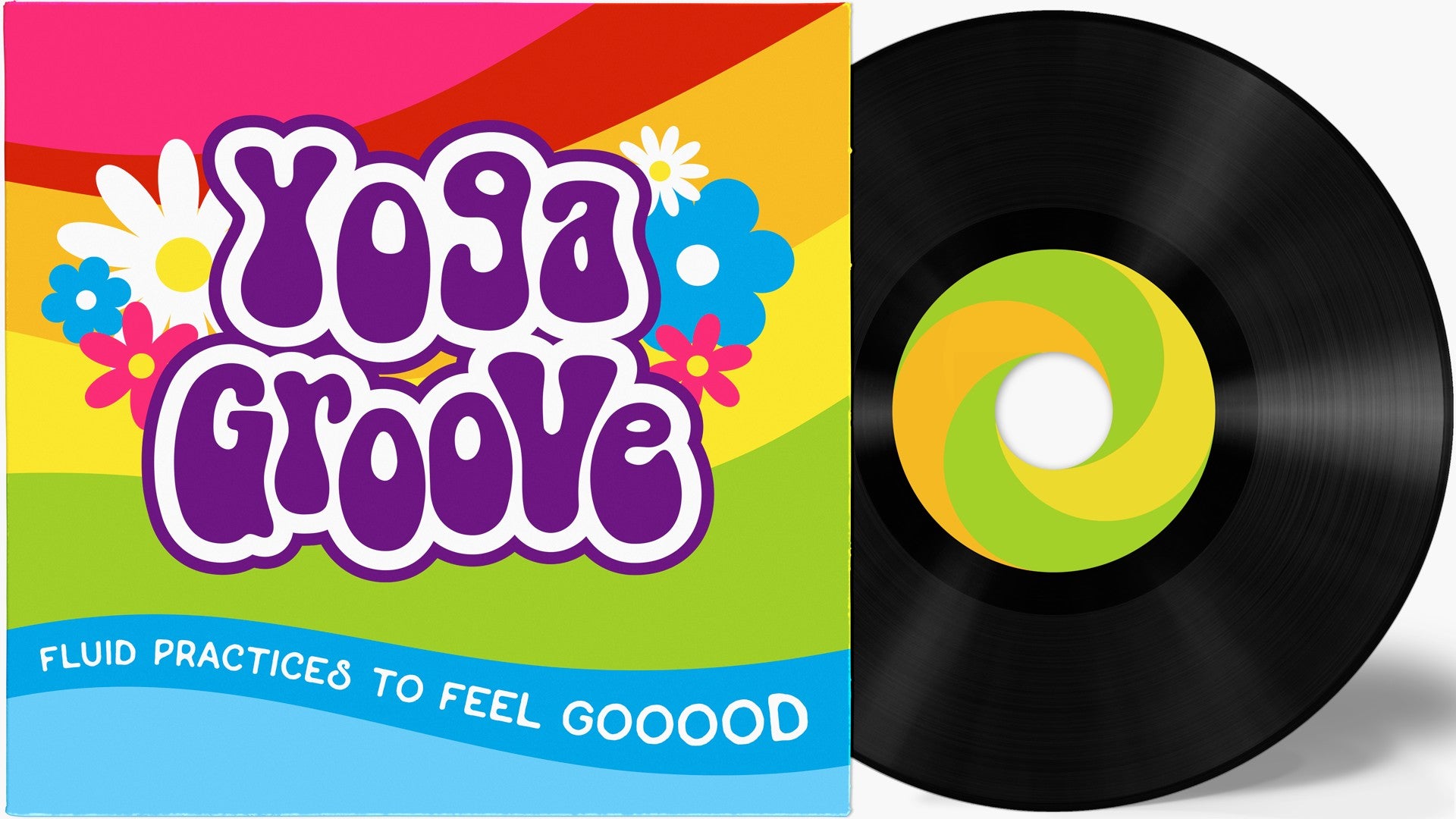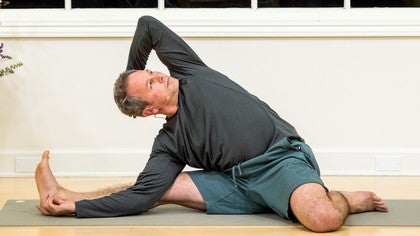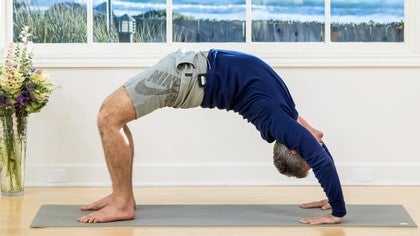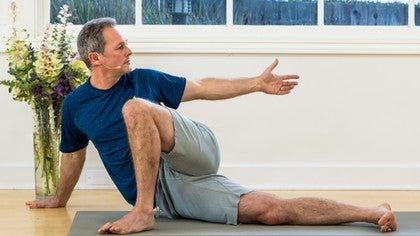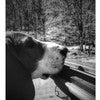Description
Transcript
Read Full Transcript
We're going to do a little program for backyard, so let's go to the ground and start. The first thing we're going to do is cat and cow while lying on her back, so the hands nice and relaxed down. I'm going to arch the back on an inhale, if you're not sure what an arch is, you should be able to put your hands underneath your back on an inhale. But on the exhale, feel your back release into the ground, now there's two ways you can encourage that. One push into your feet and feel your hips roll and flattens out your lower back, exhale and then inhale, arch.
So we have the muscles creating this lovely curve in the lower back on the inhale, feel everything open up. Exhale, we take out that curve, push into the feet and release. Now the other group of muscles that can do that is the abdominal muscles, so we're going to try and integrate those. Inhale open, curve, arch the back, exhale, feel the ribcage close down and maybe you can let the feet help. Two more, inhale and exhale.
Now we're doing something very specific for the back. Last one, we're squeezing the muscles and shortening them, getting a hold of them and then just like you're stretching taffy, just let them lengthen and down. So we're going to do the same thing again but now we're going to add the head. Hands behind the head, take an inhale, arch the back like we've done before but on the exhale part A, flatten the back and part B, roll the head up and feel it all shorten. You should be getting a nice stretch in the back, only going to do a few of them.
Inhale now you have to go back to the beginning, you don't have to come down, you open, arch, the elbows go down, exhale, first the back, then head and shoulders lift so it's like we're stretching the back, north, south, east, west. Squeezing into the tissue, inhale with the focus on the back muscles, exhale lengthening the back, moving the body up. Last one, inhale, exhale and now I'm going to come over and lie in the belly for the third action. Now remember we're not going for big movement, we're looking for feeling the sensation, it's the connection to the brain. As I lay down, my right hand is going to go by my chest, the left hand is going to go by my face, I'm going to relax my head down.
Now the opposing, when I lift my left hand at the same time, I lift my right leg, I'm going to do it three times and then change sides. So down, exhale, you need the same action as that with the inhale, with the back muscles. Exhale up, exhale, inhale up and exhale, feel them lengthen when you come down. Last one, inhale up and exhale. Now we're going to do that on the other side and people talk to me about back stuff but there's so many muscles.
So right now if I be more specific it's primarily the extensors, we'll try the other side. Hand down and to the face, this time it will be right hand lifts, left leg lifts. Inhale up, exhale down. Two more, inhale up, exhale down. Inhale up and exhale down.
Now I'm going to come and lie on my back one more time. So I've really got to get into those muscles and now I'm going to try and release them. So this will be the deepest version of this sequence of four. Again, bending the legs, knees are hip distance, feet are hip distance, in close. This time we're going to do the diagonals, both hands behind the head and we don't leave the arms up, we go to full range extension, hands behind the head, fingers interlaced.
My left hand is going to hold my left knee and like I'm pulling a pint, I don't know if you were ever in a pub, I'm Irish, it's just something I had to do, squeeze. So the arm is going to help that lower back lengthen. No bear comes near. Here we go. Inhale, arch, remember the arch?
It's not hang out in the inhale, but on the exhale, first remember, we lower the back. Part two, we lift the head. Part three, round and it's intentionally rounding, so we're stretching the tissue. The inhale takes us all the way back with an arch, inhale, there's the arch, there's the squeeze, exhale, inhale, exhale, pull that pint, inhale, last two, exhale, last one, inhale, exhale, we're going to change sides. Now don't get caught up with keeping it short, the full release comes from going in the range.
Holding the right knee with the right arm, left hand behind the head. We do that, the three things we notice is on the inhale we arch. On the exhale, lower the back, head comes up, part three, spinal twist, inhale, let the knee move away as the back arches, exhale, pull the knee in to relax the back. Now going straight for the, imagine that your back muscles are pulling the knee away, inhale. You really use them to pull that knee away, but on the exhale you're softening.
Just two more. Just one more. And that might give you enough relief on a very specific aspect, a very specific area and region in your back, but because someone comes to you and says, I have back problems, you start to notice where's the problems in your back. So the next thing we're going to talk about is called the quadratus lumbarum, specifically it's the one that makes you dance like this, or if you are hitting something, one stabilizer, if it's a stabilizer, when you kick a ball, that's the part that says I got you. So if this is it in its moving state, this is it in its stability state.
Now I'm going to put my left leg out, this will help, and I'm going to bring my right arm to the sky. Now as I reach up my right arm, I should feel an opening here, reach up, and I'm going to lean to my left, and I can feel this lovely tension line opening. So that's very, that area there that can take, give an awful lot of relief in the back. Now I want to squeeze that same muscle, so I'm going to come down for a side body stretch. Once I lift this knee, boom, and we just open up.
Now if that's too much, you can keep the knee in the ground, or bring the leg out straight. Come back up one more time, right arm up, lean to the left, inhale up, and this time we're going to go into right angle pose, so you can bring the hand down, leave the knee there and bring the arm over, or if you like to give it a squeeze, lift up and reach, and down. Now, we'll go straight to the other side. Right leg out, and we'll just do it twice, inhale, left arm up, exhale, soften, feel that, inhale up. Now we're going to squeeze that muscle, hand down, knee lifts, inhale open, exhale down, come back up, inhale, exhale, fold, inhale up, and we'll go into it with the extended version, hand down, core connection, knee lifts, and all the way over, and back and down.
So that opens up muscle number two, going to number three, and this idea that your back and your front are separate. We notice the relationship, it's called reciprocal inhibition. If I use something here, I create an opportunity for an opening here. So going to all fours, we've already done cat and cow, but now we're going to use it with the leg and a little bit of core work. Inhale, right leg back, feel that length, but on the exhale, forehead to knee, give it a squeeze.
Keep that core connection as you lengthen it away, exhale, give it a squeeze, and knee comes down. Now we're going to try that same thing on the other side, inhale, kick that door in, Jackie Brown, exhale, forehead to knee, the thinker, inhale, exhale, and down. So that just gives the idea that when we squeeze here, we create an opportunity to release in the back. And now we're going to go into some lunges, so I'm going to face towards the front of my mat with left leg forward and right leg back, stretching and connecting to the abdomen and then moving forward into a lunge. Feel that lovely stretch in the quad, the hamstring, and lift up.
Just releasing, now if you'd like more, you can add the hands, remember every time you move in and out, just to feel the sensation, inhale up, already feeling the hip flexor and the quads more, and if we can get those released, the hip can change, you can take pressure off the back, inhale up too, and down too. Now if it feels okay, and you might need to roll up your mat, I'm going to bend the back leg and see if I can grab my foot, not necessary, just an option. So when we grab it, I open up and just leave the knee there. If that feels okay, I push the foot open the chest, don't destabilize in the core and just lean forward, maybe add another hand and feel that lovely stretch in the quad. It doesn't have to look fancy, just the sensation.
And now we're going to go from here to a little twist, again, this might be A or B, this is A, one, and back, and this is B, where we just bend the back leg, and lunge. Now some of you might feel this is it, or if I wanted to go a little deeper, just put the hand wider, right hand goes a little wider, and forward, and then come down, and stretch. So this feels nice in the quad, and I know if I can release the quad, the quad's relationship with the hips might give me a bit more freedom in the lower back. So coming out of that, and as always we're going to do just a gentle stretch in the hamstring, gentle, and the last one in this series is called, I'm going to call it, I think it's lounge asana, but I just want you to drop the hip down and turn your leg out, same thing, right hand can go wider and forward to give you space, and as you drop down, you keep the knee in and snuggle into it, and open your chest. Remember the shoulder girdle here is helping the hips release, the more I push into my right hand, the more I feel my waist and my hips start to release.
So we'll do that exact same thing on the other side, changing, I like to rebalance or recalibrate the body just with maybe one or two cat and cows, and then bring the other leg forward, and if I wasn't specific to the muscle, it's a muscle, if you think of your spine like a mast, it'd be one of the sails attached to the mast that comes across and attaches to the inner thigh, it's called a psoas. So I'm stretching that, leaning forward, hamstring, glutes, and this muscle, the one that gives us the curve in the lower back. Now if I let my belly go, the hips will tilt, so I want to really feel a connection here as I sink into it. Remember how we did add a little bit more, we call it just a little wave, inhale up, oh that feels deeper, and down, and just be curious how far can I go and stay soft, and down. Now you have all these muscles in the leg, so we're going to move to the, of the quadriceps the muscles closer to the knee, the vastus, and when we grab that foot, here we go, pull the handbrake, I said never pull the handbrake, this is it, pull the handbrake.
If I can, I can maybe square my shoulders, that might deepen it, if I can maybe this will help square the shoulders, open in the throat, just that feeling can help open the tissue a little bit more, none of this is necessary, it's just again to create a sensation. So after that stretch, we might go into a twist, like we did before, so it's called Twisted Monkey, and this time I'm going to bring, to make it easy on myself, left hand out, to the left, and forward, and that allows that left hip to come down, and then when I bend that leg, that left leg, here we go, open the cell, and release, and then remember the last one, the closest name of Godford is that lounge pose, because it has that sense to it, so I'm going to drop down onto the outer part of my left leg, and again, whatever feels right, the higher I can get my shoulders over the hips, the more I feel that stretch in the outer hip, and after a while it starts to feel nice and free, that can sometimes feel intense for somebody. Go through a little cat and cow, inhale, and exhale, inhale, and exhale, and now we're going to get to other muscles in the hip area, and relieving those other areas close to the back can diffuse the tension, so the next one, it's the pigeon, and it's known best for relieving sciatica, and or it's a specific stabilizer, so it's known best for relieving sciatica, and it's a stabilizer called a periformis, here we go, stretch my butt, and there's so many variations, so sometimes I lock into the alignment cues of knee must be outside, hip, ankle must be, and sometimes I just kind of go for it, and see how it feels, so we turn, and really the only thing I'm asking myself is am I getting relief in the hip, or am I just in a funny shape that might hurt my knee, so to help me when I took my toes, it helps me connect to the core, and then at some point I feel the weight down through the hips, that's good, as best we can, we just land the plane, and sit with that for just a few moments, man, you already know this, I'm gonna slide around, give a gentle twist, give it a hug, give it a little twist, other side. And at some point just go, yeah, this is good, and release down, hmm, and that's that, and give it a little twist to come out of it, hmm, and now we're just gonna give a little arm shoulder relief, recognizing part of the spine, so when I bring the arms across the body, like so, I just snuggle it forward, one, two, so I'm on my elbows, and kind of just slide, one, two, take a deep breath in, and relax, now if it feels intense on a particular arm, you might feel compelled to roll away from it, but that will deepen the stretch, so if you feel an intensity in one arm, roll into it, and that relieves the pressure, hmm, I'm gonna do that shape on the other side, and remember the alternative to that would be doing one arm at a time, so I'll just give you a display, this would be me doing one arm, and releasing and lengthening the tissue at the end of the other arm, and you would do that either side, otherwise, change sides, and this side I think, one, two, one, two, reach, reach, settle in the center, and release, hmm, you can dance from side to side and play and now we're gonna work our way towards our final resting pose, it's called constructive rest, and I'd like to give you the go, I think it's primarily used in the Alexander technique, but it works, and it's a good time to teach yourself to be skilled, still, so as we lie down, the feet don't even go in or out, we just stay in neutral, we lie down with the knees bent, which allows the lower back to release, but we have to keep our awareness on the spine, no listening to music, no fluffy clouds, and the idea is once the relationship with your mind and your back muscles strengthen that you become more fluent in your body, and this is really a lot of what the yoga practice is, there's no disconnect, so I'm gonna ask you to be still, and even though I'm talking, you be still and be quiet, and I'm gonna snuggle back onto the mat, so my head is also on the mat, consciously releasing, so there's a specific part of the brain that deals with patterns, called the homunculus, and you don't need to remember anything I say, just know that it isn't hairy fairy stuff, this is, I'm always wary of pseudoscience, now once these patterns of our body get established, there's another tissue in the body called fascia, which literally means bandage, and that supports our patterns, so how we sometimes might have problems changing those patterns is the support systems got built up, that second thing I talked about, the fascia, it takes a while to let go, you have to be here a while, the patterns that takes a while too, now don't try and push your back into the ground, just notice your back, lengthen your neck, soften your body, and normally you're asked to stay in this position for anywhere between two to fifteen minutes, I'm only going to stay two, and if you were to stay for the whole fifteen minutes, you could do the breathing practice, which is something we've recorded on another day, but you could use the breathing practice while being still. You're asked to keep your eyes open, so even though we're using this for shavasana, this time, the awareness is that you don't drift off, that it's a conscious work, conscious relaxation, when you're ready, take an inhale, arch, exhale both knees into the chest, squeeze, hands behind the knees, if it's okay you can rock up, or just slowly make your way up.
Sitting tall, hands together, comes to the forehead for clarity of thought, to the lips for clarity of speech, to the heart for clarity of action, so we're clearing everything we think, everything we say, everything we do, namaste.
Yoga Groove: Paul Hardiman
Comments
Opening the fascia is what I am striving for, to get a great release in my hips and low back
This practice I will do daily. Grateful for your teaching.
You need to be a subscriber to post a comment.
Please Log In or Create an Account to start your free trial.
